#princess hildegarde of bavaria
Text
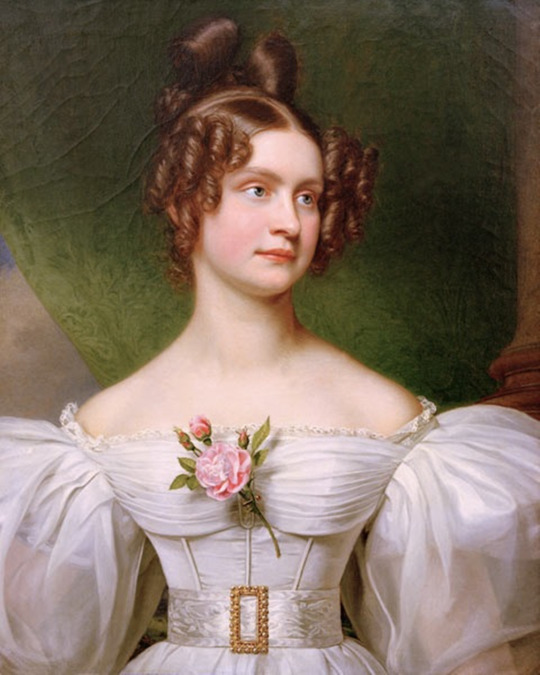

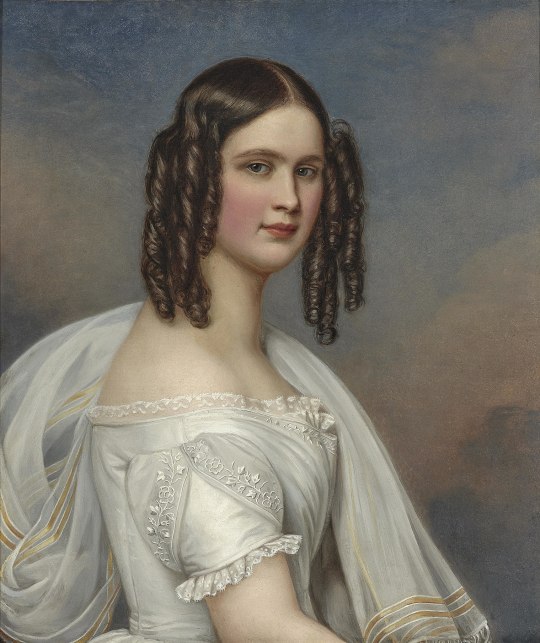
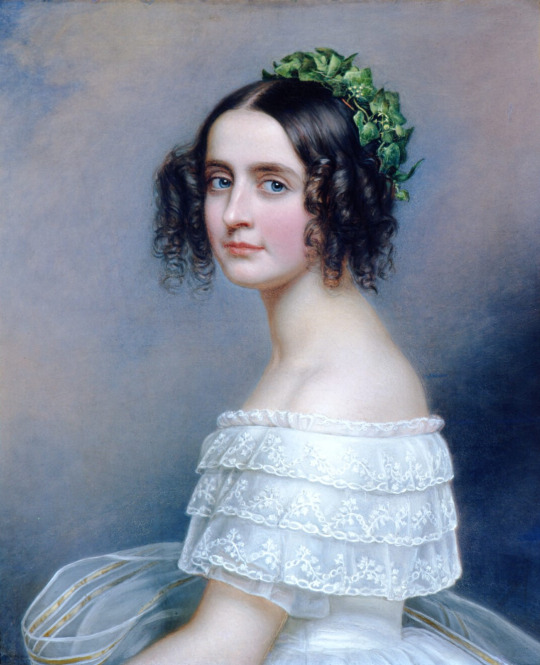
The daughters of King Ludwig I of Bavaria, by Joseph Karl Stieler. Mathilde, Adelgunde, Hildegard and Alexandra.
#mathilde caroline of bavaria grand duchess of hesse and by rhine#adelgunde of bavaria duchess of modena#hildegard of bavaria archduchess of austria teschen#princess alexandra of bavaria#artist: joseph karl stieler#house of wittelsbach
60 notes
·
View notes
Photo
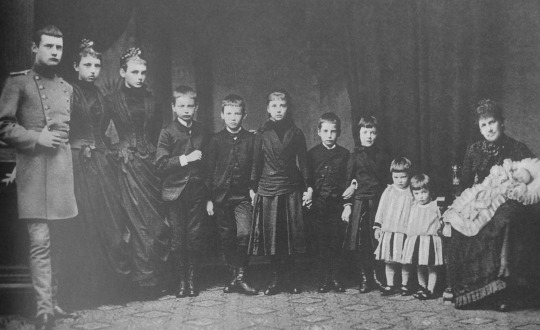
Maria Theresa of Austria-Este , Queen of Bavaria with 11 of her children: From left: Crown Prince Rupprecht, Princess Adelgunde, Princess Marie, Prince Karl, Prince Franz, Princess Mathilde, Prince Wolfgang, Princess Hildegard, Princess Wiltrud, Princess Helmtrud and Queen Maria Theresa with Princess Dietlinde in her lap
Dietlinde died at age one and one more princess, Gundelinde, was born after her death. Another daughter, Notburga, was born between Hildegard and Wiltrud, but only lived for five days.
#Maria Theresa of Austria-Este#house of wittelsbach#crown prince Rupprecht#Adelgunde of Bavaria#marie of Bavaria#mathilde of Bavaria#hildegarde of Bavaria#wiltrud of Bavaria#helmtrud of Bavaria#dietlinde of Bavaria#prince karl#prince franz#prince wolfgang#long live the queue
26 notes
·
View notes
Text

As I'm currently indexing this blog or, rather, meta-tagging posts in my new version of it on the Blogger website (I will post proper link as soon as it's finished), I decided to compile a list of all the women who feature (or receive a mention however fleetingly) within it. I have tried to trawl the blog ''with a fine toothcomb'', but I'm bound to have missed a few names - oh well! Here is the list as complete as I can muster. The women appear in (broadly) alphabetical order by first name. *** NB it is still a work in progress ***
VOCALISTS & MUSICIANS
Alice Waterhouse (flute) * Amy Winehouse * Angel Olsen * Annie June Callaghan * Ari Up & The Slits * Be Good Tanyas, The * Billie Holiday * Bjork * Black Belles, The * Cait O’ Riordan (Pogues) * Calista Williams (Bluebird) * Cindy Wilson & Kate Pierson (The B52s) * Cistem Failure * Clementine Douglas * Cosey Fanni Tutti * DakhaBrakha (well, 3/4 of them!) * Debbie Harry * Edith Piaf * Elizabeth Morris (Allo Darlin') * Holly Golightly * HoneyLuv * Katy-Jane Garside * Kelis * Kim Deal (Pixies & Breeders) * Maxine Peake * Maxine Venton & Mimi O'Malley (Captain Hotknives) * Meg White * Melanie Safka * Nico * Nina Simone * Patti Rothberg * Penny Ford (Snap!) * PJ Harvey * Rhoda Dakar (Special AKA) * Seamonsters, The * Siouxsie Sioux * Suzanne Vega * Tray Tronic * Trish Keenan (Broadcast)
VISUAL ARTS
Annegret Soltau * Anne Ophelia Dowden * Artemisia Gentileschi * Barbara Regina Dietzsch * Beverly Joubert * Camille Claudel * Clara Peeters * Dale DeArmond * Doreen Fletcher * Eleanor Fortescue-Brickdale * Élisabeth Sonrel * Elisabetta Siriani * Elizabeth Mary Watt * Ella Hawkins * Evelyn De Morgan * Frida Kahlo * Gertrude Abercrombie * Helen Martins * Kate Gough * Laura Knight (Dame) * Leonora Carrington * Lily Delissa Joseph * Liza Ferneyhough * Magdolna Ban * Mandy Payne* Mary Delany * Miina Akkijrkka * Ndidi Ekubia * Pamela Colman-Smith * Paula Rego * Rachel Gale * 'Romany Soup' * Sarah Vivien * Shirley Baker * Siirkka-Liisa Konttinen * Sofonisba Anguissola * Sonia Delaunay * Tish Murtha * Vali Myers * Vanessa Bell
COMEDY, DANCE & DRAMA
Alicia Eyo & Carol Morley ('Stalin My Neighbour') * Claire Foy * Daisy May Cooper * Gabrielle Creevy & Jo Hartley ('In My Skin') * Isadora Duncan * Jessica Williams ('Love Life') * Lesley Sharp, Michelle Holmes & Siobhan Finneran ('Rita, Sue & Bob Too') * Michaela Coel ('I May Destroy You') * Morgana Robinson * Samantha Morton * Yasmin Paige (Jordana Bevan in ‘Submarine)
WRITERS, JOURNALISTS, SCHOLARS & POETS
Agatha Christie (MBE) * Andrea Dunbar * Anaïs Nin * Angela Thirkell * Anna Funder * Anna Wickham * Edith Holden * Elizabeth O'Neill * Enid Blyton * Harriet Beecher Stowe * Helen Castor (Dr.) * Hilary Mantel * Janina Ramirez (Dr.) * Jeannette Kupfermann * Jenny March (Dr.) * Jenny Wormald (Dr.) * Lia Leendertz * Mary Oliver * Orna Guralnik (Dr.) * Rachel Beer * Susie Boniface * Virginia Woolf
HISTORICAL FIGURES
Anne, Queen of Great Britain * Anne Boleyn, Queen of England * Anne of Cleves, Queen of England * Boudicca, Queen of the Iceni * Cartimandua, Queen of the Brigantes * Catherine de’ Medici, Queen Consort/Regent of France * Catherine Parr, Queen of England * Catherine of Aragon, Queen of England * Catherine of Valois, Queen of England * Christine de Pizan * Cixi, Empress of China (aka Empress Tz'u-hsi ) * Eleanora of Austria, Queen of France * Eleanor of Aquitaine, Queen of France; Queen of England; Duchess of Aquitaine * Eleanor of Castile * Eleanor Talbot ("The Secret Queen") * Elizabeth I Queen of England * Elizabeth Woodville, Queen Consort of England * Elizabeth of York, Queen Consort of England * Elizabeth Stuart, Queen of Bohemia * Hatshepsut, Pharaoh of Egypt *Hildegard of Bingen * Isabeau of Bavaria, Queen of France * Isabella I, Queen of Castile * Isabella of Aragon, Princess of Asturias * Isabella of Portugal, Empress Consort of Holy Roman Empire and Queen Consort of Spain, Germany & Italy * Isabella of France, Queen of England * Jacquetta of Luxemburg * Jane Grey (Lady), Queen of England for Nine Days * Jane Seymour, Queen of England * Juana (aka Joanna), Queen of Castile * Katherine Howard, Queen of England * Louise of Savoy, Regent of France * Margaret of Anjou, Queen Consort of England * Margaret of Austria [check which one] * Margaret Beaufort, Lady * Marie Antoinette, Queen of France * Mary I, Queen of England * Mary II, Queen of England, Scotland & Ireland * Mary, Queen of Scots * Mary of Austria [check which one] * Mary of Burgundy, Duchess * Matilda, Holy Roman Empress * Melisende, Queen of Jerusalem * Sophia of Hanover, Electress * Tatya Betul, Empress of Ethiopia * Theodora, Empress of Byzantium * Victoria, Queen of England & Empress of India
SAINTS & BIBLICAL/CHRISTIAN REFERENCES
Anna (wife of Tobit) * Apollonia (Saint) * Barbara (Saint) * Catherine of Alexandria (Saint) * Ecclesia * Eve (the first woman) * Felicitas of Rome (Saint) * Genevieve (Saint) * Godeberta * Jael * Jezebel * Judith * Lucy (Saint) * Margaret of Scotland (Saint) * Mary Magdalene * Rahab * Rose of Lima (Saint) * Synagoga * The Queen of Sheba * Thérèse of Lisieux (Saint) * Virgin Mary, The* "Whore of Babylon", The * Ursula (Saint)
MYTHOLOGICAL
Anat * Asherah * Astarte * Atalanta * Aurora * Baba Yaga * Circe * Chhinnamasta * Clio/Kleio * Demeter (Rmn: Ceres) * Dido, Queen of Carthage * Durga * Elaine of Astolat * Europa * Eurydice * Hathor * Hesperides * Io * Isolde/Iseult * Isis * Juno (Gk: Hera) * Kali * Kriemhild/Gudrun * Kudshu * Lakshmi * Persephone (Rmn: Proserpine) * Radha * Sabine Women, The * Sati * Sedna * Sirens, The (half-female, half-bird) * Three Graces, The * Valkyries, The * Venus (Aphrodite)
WIVES, MUSES, CONSORTS & SIGNIFICANT OTHERS
Anastasia Romanovna (wife of Ivan the Terrible) * Anne Hyde (1st wife of James, Duke of York; she did not live long enough to see him become James II) * Anne Lovell (wife of Sir Francis Lovell) * Anne of Denmark (wife of James VI of Scotland/James I of England & Ireland) * Bella Chagall (wife of Marc Chagall) * Catherine of Braganza (wife of Charles II) * Charlotte of Mecklenburg-Strelitz (Queen of England as wife of George III) * Clementine Churchill (wife of Winston Churchill) * Diane de Poitiers (royal mistress to the French king, Henry II) * Emma Hamilton, Lady (mistress of Lord Horatio Nelson) * Evelyn Pyke-Nott (wife of John Byam Shaw) * Françoise Gilot (partner of Pablo Picasso) * Frances Grey, Duchess of Suffolk (mother of Lady Jane Grey) * Henrietta-Maria (wife of Charles I) * Lady Martha Temple (wife of Sir William Temple) * MacDonald sisters, The (Alice, Georgiana, Agnes and Louisa) * Marguerite of Navarre/Angoulême (sister of French king, Francis I) * Mary of Modena (2nd wife of James VI and I, King of Scotland, England, and Ireland) * Mary Shelley (mentioned as wife of Percy Bysshe Shelley, though a renowned author in her own right) * Mary Soames (daughter of Winston Churchill & wife of Christopher Soames) * Mary Stuart (daughter of Charles I and mother of the future William III) * Mary Watts (wife of George Frederic Watts, and designer and artist in her own right) * Olga Khokhlova (1st wife of Pablo Picasso) * Portia (wife of Brutus) *
2OTH CENTURY & MODERN DAY
Christabel Pankhurst * Emily Wilding Davison * Emmeline Pankhurst * 'Gulabi Gang' * Hannah Hauxwell * Helen Keller * Hilary Clinton * Liz Truss * Margaret Campbell, Duchess of Argyll * Mata Hari * Melina Mercouri * Nazanin Zaghari-Ratcliffe * Rahima Mahmut * Sylvia Pankhurst *
6 notes
·
View notes
Text
Magazine "Ueber Land und Meer" illustration depicting young German unmarried Princesses in 1895.
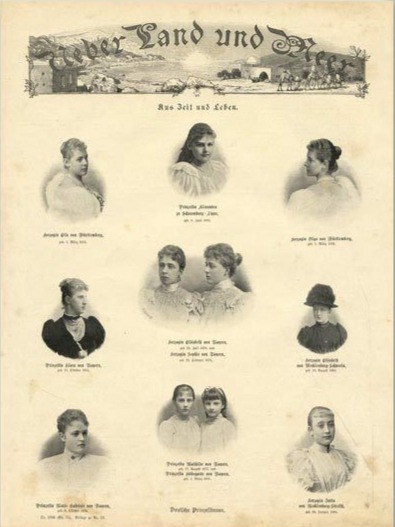
Back row: Duchess Elsa of Württemberg, Princess Alexandra of Schaumburg-Lippe and Duchess Olga of Württemberg.
Back row: Duchess Elsa of Württemberg, Princess Alexandra of Schaumburg-Lippe and Duchess Olga of Württemberg.
Middle row: Princess Clara of Bavaria, Duchesses Sophia Adelheid and Elisabeth in Bavaria, and Duchess Elisabeth Alexandrine of Mecklenburg-Schwerin.
Front row: Duchess Marie Gabrielle in Bavaria, Princesses Mathilde and Hildegarde of Bavaria and Duchess Jutta of Mecklenburg-Strelitz.
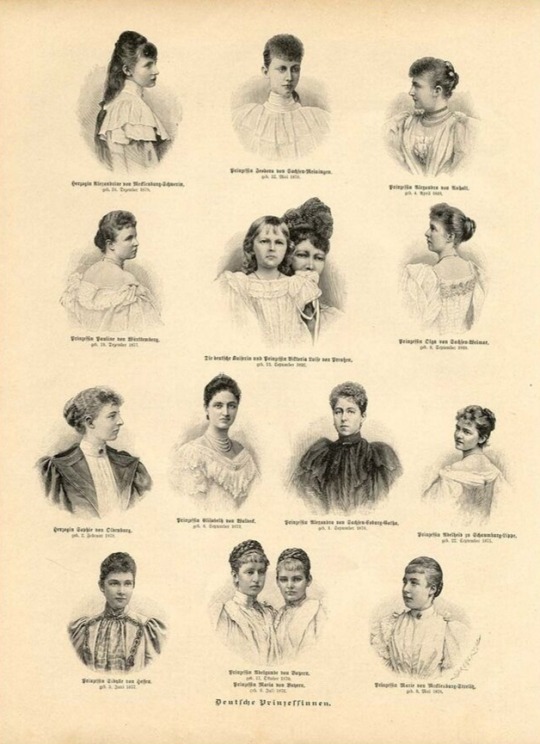
Back row: Duchess Alexandrine of Mecklenburg-Schwerin, Princess Feodora of Saxe-Meiningen and Princess Alexandra of Anhalt.
Middle row (1) Princess Pauline of Württemberg, German Empress Augusta Victoria with her daughter, Princess Victoria Louise of Prussia and Princess Olga of Saxe-Weimar-Eisenach.
Middle row (2): Duchess Sophia Charlotte of Oldenburg, Princess Elisabeth of Waldeck and Pyrmont, Princess Alexandra of Saxe-Coburg and Gotha and Princess Adelaide of Schaumburg-Lippe.
Front row: Princess Sybille Marguerite of Hesse, Princesses Adelgunde and Maria Ludwiga of Bavaria, and Duchess Marie of Mecklenburg-Strelitz.
#duchess olga of württemberg#duchess elsa of württemberg#duchess jutta of mecklenburg-strelitz#duchess marie of mecklenburg-strelitz#duchess alexandrine of mecklenburg-strelitz#duchess elisabeth alexandrine of mecklenburg-strelitz#duchess sophie adelheid in bavaria#duchess elisabeth in bavaria#duchess marie gabrielle in bavaria#princess adelgunde of bavaria#princess maria ludwiga of bavaria#princess clara of bavaria#princess mathilde of bavaria#princess hildegarde of bavaria#princess adelaide of schaumburg-lippe#princess alexandra of schaumburg-lippe#princess feodora of saxe-meiningen#princess olga of saxe-weimar-eisenach#princess victoria louise of prussia#princess alexandra of saxe-coburg and gotha#princess sybille marguerite of hesse#princess elisabeth of waldeck and pyrmont#duchess sophia charlotte of oldenburg#princess pauline of württemberg#german royalty#german royal#1895#1890s#german empress augusta victoria
37 notes
·
View notes
Photo
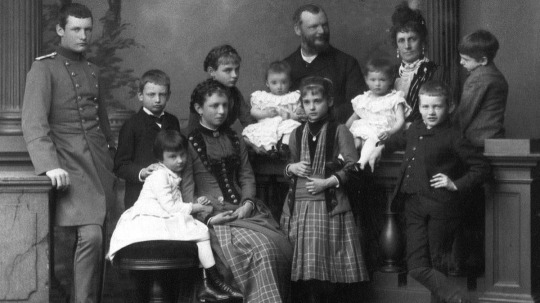
Ludwig III of Bavaria with his family, 1885
#Ludwig III of Bavaria#Maria Theresia of Austria-Este#Rupprecht Crown Prince of Bavaria#Princess Adelgunde of Bavaria#Maria Ludwiga Princess of Bavaria#Princess Mathilde of Bavaria#Prince Wolfgang of Bavaria#Prince Franz of Bavaria#Prince Karl of Bavaria#Princess Hildegard of Bavaria#Princess Wiltrud of Bavaria#1880s#wittelsbach#bavarian royal family
12 notes
·
View notes
Photo

This is a wip list of every kingdom canon to the Frozen universe. These are pulled from books, comics, movies, and tv series. I have added what real-world countries each one is similar to in geography and culture, as well as the names of their rulers/representatives. Please let me know if I’ve missed any.
England
Weselton - The Duke and his nephew Lord Wolfgang (Based on England)
Snoob - The Baron and Baroness (Based on Ireland)
Riverland - (Based on Wales)
Nordic
Arendelle - Queen Elsa & Princess Anna (Nordic based)
Sankershus - Queen Disa (Sweden based)
Vesterland - King Jonas and Princess Mari, formerly ruled by sisters Inger and Sissel. (Sweden based)
Denmark
Southern Isles - Caleb, Lars, Runi & Runo, and Hans Westergaard
Netherlands
Vassar - King Nicolas & Princess Runa
Bavaria
Corona - King Queen , and Princess Rapunzel (Based on Germany)
Kongsberg - (Austria)
Latin America
Avalor - Princess Elena (Based on Mexico & Peru)
Eldora - Queen Marisol (Based on South America)
Asia
Chatho - Queen Colisa and SoYun (based on East Asia)
Eastern Europe
Blavenia - (Based on Ukraine)
Vakretta - Princes Wils & Freluke, ambassador Mitya and his wife Galia. (Based on Russia)
Mediterranean
Tirula - Prince Eric (Based on Greece/Italy/Spain)
Middle East
Zaria - King Stebor & Queen Renalia (based on Persia)
Unknown
Enchancia - King Rolland II & Queen Miranda
Freezenberg - King Henrick, Princesses Astrid & Hildegard
#canon kingdoms#please do not reblog#you may like this post to use as a reference for your own roleplaying
4 notes
·
View notes
Text

Princess Hildegard of Bavaria. Wife of Archduke Albert of Austria-Teschen. By Joseph Karl. Stieler.
#joseph Karl Stieler #austria teschen#erzherzogin#erzherzogtum österreich#haus wittelsbach#erzherzogin hildegard
32 notes
·
View notes
Photo

Archduchess Maria Theresa of Austria (1845–1927), daughter of Archduke Albert, Duke of Teschen and Princess Hildegard of Bavaria.
15 notes
·
View notes
Photo

Princess Hildegard of Bavaria, Archduchess of Austria
17 notes
·
View notes
Photo
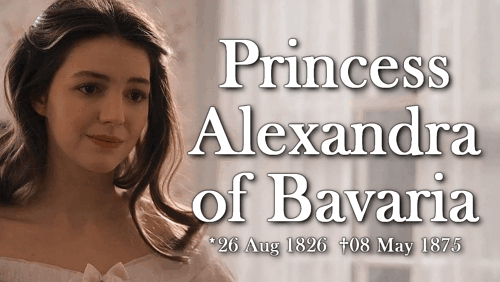





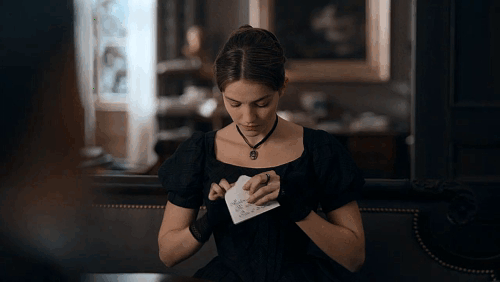



House of Wittelsbach: Princess Alexandra of Bavaria
Alexandra was born as the eight child and fifth daughter of King Ludwig I. of Bavaria and his wife Therese of Saxe-Hildburghausen. Alexandra’s siblings were King Maximilian II. of Bavaria, King Otto I. of Greece, Prince-Regent Luitpold of Bavaria, Grand Duchess Caroline Mathilde of Hesse and by Rhine, Duchess Adelgunde of Modena, Archduchess Hildegard of Austria and Prince Adalbert of Bavaria. But not only her siblings were of high-rank, among her aunts were Empress Caroline Augusta of Austria, Queen Elisabeth Ludovika of Prussia, Queens Amalie Auguste and Maria Anna of Saxony, Archduchess Sophie of Austria and Duchess Ludovika in Bavaria. Through the latter two, she was also a first half-cousin of Emperor Franz Joseph of Austria and his wife Elisabeth “Sisi” in Bavaria.
After his divorce, Louis Lucien Bonaparte, a cousin of Napoleon III., asked for Alexandra’s hand but her father declined. He thought it impossible to marry his daughter to a Napoleon but Alexandra’s fear of touch might have been another reason for him to decline a marriage. Alexandra stayed unmarried for the rest of her life. Instead her father made her abbess of the Royal Chapter for Ladies of Saint Anne in Munich and Würzburg.
In 1852, Alexandra began her literary career as an author and French to German translator. Several of her books were dedicated to charities and their earnings donated towards their cause.
Like other members of the House of Wittelsbach, Alexandra suffered from mental health issues too. She was obsessed with cleanliness and only wore white for a time. In her early twenties, she was haunted by the delusion of having swallowed a whole glass piano as a child. When she had to throw up one day, her servants tried to trick her by throwing a miniature piano into her puke to show her that she finally got rid of it.
Despite all her troubles, Alexandra was very close with her mother and tried to be as useful and kind as possible after her father’s death. Alexandra especially took care of the poor in Aschaffenburg. In 1860, she sponsored a public kitchen for the poor and sick there.
Alexandra died on May 8th, 1877, at the age of only 49 at Nymphenburg Castle. The same day and place, her younger brother Adalbert died too. But while Adalbert is buried at St. Michael, Alexandra rests in the Wittelsbach Crypt of Theatine Church in Munich.
// Ella Hunt in Dickinson
#women in history#historical women#historyedit#1800s#19th century#Alexandra of Bavaria#House of Wittelsbach#Royal Women of Bavaria
159 notes
·
View notes
Photo

Princess Maria Theresa of Bavaria, née Archduchess of Austria-Este, with her husband, Ludwig, later King of Bavaria, and their ten children: Rupprecht, Karl, Hildegard, Adelgunde, Marie, Helmtrud, Mathilde, Wiltrude, Franz and Wolfgang in 1885.
#Princess Maria Theresa of Bavaria#Archduchess Maria Theresa of Austria-Este#Queen Maria Theresa of Bavaria#king ludwig iii of bavaria#Crown Prince Rupprecht of Bavaria#Princess Mathilde of Bavaria#Princess Mathilde of Saxe-Coburg and Gotha#Princess of Bavaria#Archduchess of Austria#Wittelsbach#Hapsburg#Royalty#histolines
19 notes
·
View notes
Text

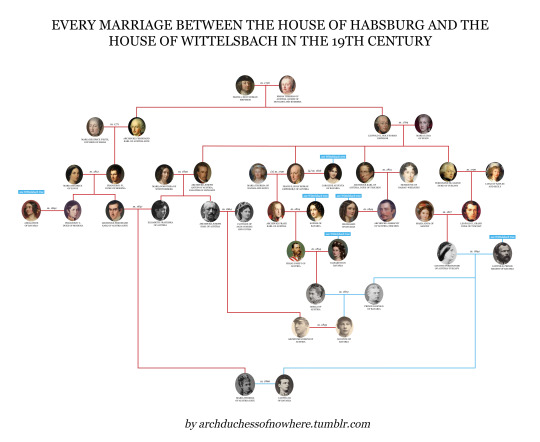
In the 19th century, there were 9 marriages between the House of Wittelsbach and the House of Habsburg:
1816, 29 October. Emperor Franz I of Austria (1768-1835) married Princess Caroline Augusta of Bavaria (1792-1873). They had no children.
1824, 4 November. Archduke Franz Karl of Austria (1802-1878) married Princess Sophie of Bavaria (1805-1872). They had five children, four who survived infancy.
1842, 30 March. Francesco V, Duke of Modena and Archduke of Austria (1819-1875) married Princess Adelgunde of Bavaria (1823-1914). They had one daughter who did not survive infancy.
1844, 16 April. Prince Luitpold of Bavaria, future Prince Regent, (1821-1912) married Archduchess Auguste Ferdinande of Austria-Tuscany (1825-1864). They had four children.
1844, 1 May. Archduke Albrecht of Austria, Duke of Teschen (1817-1895) married Princess Hildegard of Bavaria (1825-1864). They had three children, two who survived infancy.
1854, 24 April. Emperor Franz Josef I of Austria (1830-1916) married Duchess Elisabeth in Bavaria (1837-1898). They had four children, three who survived infancy.
1866, 20 February. Prince Ludwig of Bavaria, future King Ludwig III, (1845-1921) married Archduchess Maria Theresa of Austria-Este (1849-1919). They had thirteen children, eleven who survived infancy.
1873, 20 April. Prince Leopold of Bavaria (1846-1930) married Archduchess Gisela of Austria (1856-1932). They had four children.
1893, 15 November. Archduke Joseph August of Austria (1872-1962) married Princess Auguste of Bavaria (1877-1964). They had six children, four who survived infancy.
#zoom in for better quality!#this was so ridiculously hard to make that it actually took me A YEAR to put it together#because I did it and re-did it several times until it looked sort of decent#I still don't like much how it came out but well. it be like that sometimes#house of habsburg#house of wittelsbach#family tree
37 notes
·
View notes
Photo










Royal Birthdays for today, June 10th:
James Francis Edward, Prince of Wales, 1688
Amelia, Princess of Great Britain, 1711
Caroline, Princess of Great Britain, 1713
Hildegard of Bavaria, Duchess of Teschen, 1825
Igor Constantinovich, Russian Prince, 1894
Tatiana Nikolaevna, Russian Grand Duchess, 1897
Marie Auguste of Anhalt, Princess of Prussia, 1898
Prince Philip, Duke of Edinburgh, 1921
George Friedrich, Prince of Prussia, 1976
Madeline of Sweden, Duchess of Hälsingland and Gästrikland, 1982
#princess madeleine#prince philip#tatiana nikolaevna#james frances edward stuart#Amelia of Great Britain#caroline of great britain#hildegarde of bavaria#Igor Constantinovich#Marie Auguste of Anhalt#prince George Friedrich#long live the queue#royal birthdays
44 notes
·
View notes
Text
Greetings!
This is Jennifer Ritchey, we spoke yesterday about working together on my Shelton Family History in order to help you as well on information about Shelton Hall. I am going to send you all the information that I gathered. If you have any questions, please let me know via email [email protected] Thank you.
To start with I will be sending you what I know about my family history.Please keep in mind this is my ancestry through my great grandmother Annie Opal Shelton. Which is the following among other royal family members:
!.Ferreolus, Tribune of Gaul m. Clarissima Femma in 382 AD
2. Tonatius Ferreolus ( b. 310 AD- 475 AD) m. Papianilla
3.Tonatius Ferreolus "Senator" (440 AD-511AD) m. Eulalia
4.Ferreolus (Senator of Narbonne)(b.485 AD-?) m. Saint Doda of Reims
5. Ansbertus m. Billild dau.of Charibert I (Merovingian)
6. Arnoldas Bishop of Metz (b.540AD-611AD m.Unknown
7. Saint Arnulf of Metz (b.582 AD-645 AD) m. Dode
8. Ansegisel (b.602 AD-679AD) m. Saint Begga
9.Pepin II of Herstal (b.633 AD-714) m.Alpaida
10. Charles Martel (B. 688-741 AD) m. Rotrude of Hesbayer
11. Pepin the Short(b.714 AD-?) m. Bertrada of Laon
12.Charlemagne (b.748 AD-814)m. Hildegarde
13 Louis the Pious m. Judith of Bavaria
14. Charles the Bald (823 AD-877AD) m. Ermentrude
15.Judith of Flanders (b.843 AD-?)m. Baldwin I, Count of Flanders
16. Baldwin II of Flanders m. Aelfthryth dau. of King Alfred the Great
17.Arnulf I, count of Flanders (b. 890 AD-965) m. Adele of Vermandois dau. of Herbert II of Vermandois
18.Baldwin III Count of Flanders (940-962) m. Mathilde of Saxony
19. Arnulf II Count of Flanders (960-987)m. Rozala of Italy dau.of King Berenger of Italy
20. Baldwin IV Count of Flanders (980-1035 ) m.Ogive of Luxemburg
21. Baldwin V of Flanders (1012-1067) m.Adele Of France
22. Matilda of Flanders(1031-1083) m. William the Conqueror, King of England
23 Henry I, king of England (1068-1135) m. Matilda of Scotland
24. Empress Matilda(1102-1167) m. Geoffrey V, Count of Anjou(Plantagenet)
25. Henry II, King of England (b. 1133-1189) m.Eleanor of Aquitaine
26.John I, King of England (1166-1216) m. Isabella, Countess of Anjouleme
27.Henry III, King of England (1207-1272) m. Eleanor of Provence
28. Edward I, King of England (1239-1307)m. Eleanor of Castile
29. Princess Elizabeth Plantagenet of Rhuddlan, Countess of Hereford (1282-1316) m. Lord Humphrey de Bohun
30 Eleanor de Bohun (1304-1363) m. James Butler I of Ormonde
31. James Butler II of Ormonde (1331-1382)m. Lady Elizabeth Darcy
32. James Butler !!! of Ormonde (1359-1405) m.Lady Anne Welles
33. James Butler IV of Ormonde ( 1392-1452) m. Joan de Beuchamp
34. Thomas Butler VII of Ormonde (1426 -1515) m. Lad Anne Hankford
35. Lady Margaret Butler (1454-1539) m. Sir William Boleyn
36. Lady Anne Boleyn (1475-1556)m. Sir John Shelton of Shelton Hall
37. Sir John Shelton II (1504-1558)m. Margaret, dau. of Sir Henry Parker
38. Sir Ralph Shelton(1530-1580) m. Lady Mary Wodehouse
39.Sir Ralph Shelton II (1560-1628) m. Lady Jane West
40.Capt, James Shelton (1580-1668)m. Anne Herbert ( Immigrated to America?)
41. Thomas Shelton(1606-1684) m. Hannah Wood
42.Capt. James Stephen Shelton(1629-1716) m. Mary Jane Bathurst
43.John Shelton(1648-1706) m. Jane Chilton
44. Thomas Shelton(?-1738) m. Winifred King
45. Thomas Shelton(1723-1808) m. Jane Bennett
46. William "Mountain Man"(1753-1827) Shelton m. Ann Lomax
47. William Bennett Shelton(1784-1860) m. Lydia Cloud
48.Andrew Jackson Shelton Sr. m. Rachel Jane Cassady
49.Andrew Jackson Shelton Jr. m. Lucretia Earle
50. John Edgenton Shelton(1892-1922) m. Opal Mcgary
51. Annie Opal Shelton m. Robbie Ray Kisselburg
52. Roberta Knell Kisselburg m. Danny Ritchey Sr.
53 Danny Ritchey II m. Anna Maria Puebla (Spanish descent)
54 Jennifer Deann Ritchey (b.1993)(me)
I am also a descendant of a Anne Elizabeth Boleyn who was born in 1475 is a possible sister of Lady Anne Boleyn Shelton who is also a daughter of Sir Geoffrey Boleyn, descended to her through Anne Herbert, wife of Captain James Stephen Shelton of whom is also a descendant of the Boleyns.. I am also the descendant of Countess Anne Parr through Anne Herbert as well. Through Anne Herbert the wife of Captain. James Shelton, through her ancestress Countess Anne Parr,wife of William Herbert (1501-1570). I a, a direct descendant of Richard Neville(1400-1460),who is the grandson of John of Gaunt(1340-1399).
That Genealogy goes as follows: 1. John of Gaunt (1340-1399) m Katherine de Roet
2. Joan Beaufort (1379-1440) m. Ralph Neville
3. Richard Neville (1400-1460) m. Alice Montague
4. Alice Neville(1430-1503)m.Henry FitzHugh
5.Lady Elizabeth Fitzhugh(1465-1507) m. William Parr Ist Baron
6. Thomas Parr(1483-1517) m. Maud Green
7.Countess Anne Parr (1515-1552) m. William Herbert
8.Henry Herbert (1538-1601)m. Catherine Talbot
9.Hebry Herbert (1567-1601) m. Lady Seymour (1565-?)
10.Anne Herbert 1588-1684)m. James Shelton (1580-1668)
Well . have to get back to college work I really hope this would help you out, next time we speak i'll do some research about Shelton Hall.
2 notes
·
View notes
Text

Prince Ludwig III of Bavaria and family in 1885.
Back row: Prince Rupprecht, Princess Adelgunde, Prince Ludwig III and his cousin Adelgunde, Duchess of Modena.Prince Ludwig III of Bavaria and family in 1885.
Middle row: Princess Maria Ludwiga, Prince Wolfgang, Princess Ludwig and Princess Wiltrud who is seated on her mother's lap, Princess Hildegard and Princess Mathilde.
Front row: Prince Karl and Prince Franz.
#king ludwig iii of bavaria#queen maria theresa of bavaria#archduchess maria theresa of austria-este#princess ludwig of bavaria#crown prince rupprecht of bavaria#prince rupprecht of bavaria#princess adelgunde of bavaria#princess maria ludwiga of bavaria#prince karl of bavaria#prince franz of bavaria#princess mathilde of bavaria#prince wolfgang of bavaria#princess hildegarde of bavaria#princess wiltrud of bavaria#duchess adelgunde of modena#bavarian royalty#bavarian royal#bavarian royal family#bavarian#german royal#german royalty#1885#1880s#mids 1880s
38 notes
·
View notes
Text
8. Kempten, Germany
The beautiful appearance of Kempten betrays a violent history -- a tragic tale of resilience that mirrors the history of Germany itself.
Though not nearly as famous as other Bavarian cities, Kempten originally forms in Celtic times. It is technically older than either Augsburg or Regensburg, and while it flies under the radar of most observers, in subtle ways Kempten qualifies as one of the most authentic German cities.
The first mention of the settlement, on paper, is 50 B.C., under the Celtic name, “Cambodunum.” It is only a small municipality at this early date, but its mention is so early that it constitutes the first official documentation of any city on paper, anywhere in Germany. In 15 B.C., the exact same year that Caesar Augustus orders the construction of nearby Augsburg, Kempten falls into the Roman Empire. Because of this, Kempten is linked together with Augsburg for the rest of history, and the two cities belong to the same Germanic province: Swabia. In Germanic times, the two cities compete for status as Swabian capital. Augsburg wins the contest, in the end, but Kempten remains an important Swabian city.
After two destruction events in Roman times, Kempten falls to the Germanic tribe called the Allemani. The opposite of the systematic Romans, the Allemani constitute a mobile, restless, and free nomadic tribe, and under their tenuous watch, the city comes, once again, under existential threat. In 683, a battle with the Franks brings the city down to ruin, the third such instance in the young life of the city. Even Augsburg does not suffer as much tribulation in its early history. Kempten seems doomed to more than its fair share of trials and tribulations.
Thankfully, in the year 700, the Medieval wheel of fortune finally turns favorably upon Kempten, in the form of the construction of a church for the Benedictine order of monks. The church takes the name of Kempten Abbey, and this becomes the new namesake for the city. From then on, the old name “Cambodunum” falls permanently out of use.
Charlemagne has a personal connection to Kempten that is very fortunate for the city. That is, he marries an Allemani princess, named Hildegard, and she loves Kempten Abbey in a special way, partly because of its beauty, and partly because of her Allemani roots. Kempten is still an Allemani city when Hildegard marries the Emperor, and she uses her direct connection to Imperial resources to provide the city with decades of financial and lobbyist support. This would be a major boon for any city, and it elevates Kempten to a high-status cultural center within the Holy Roman Empire.
Throughout the entire life of Charlemagne, the Imperial elite continue to use Kempten as a spiritual place of refuge. Furthermore, Kempten Abbey has a stunning architecture which serves as a quintessential model for the rest of the Christian world, at the time. Yet the charmed period of good fortune in Kempten lasts only as long as the protective aura of the royal couple, and when Hildegard and Charlemagne die, the city falls naturally back into its old cycle of destruction-events. Constant violence ravages the municipal area for an entire century, until the devastation finally ends, and urban reconstruction can begin anew.
From the ashes, a pattern emerges: the city always rises on the backs of its spiritual leaders. The Abbots of Kempten obtain the title of “Princes” in 1062, after which date Kempten Abbey becomes, quite officially, one of the three most powerful abbeys in the Holy Roman Empire, a status which lasts until 1803. Overall, Kempten feels very “all-or-nothing,” in its history. Either the city is being completely destroyed, or else it is one of the most prominent municipalities in the Holy Roman Empire. There is no in between, and amazingly, each time the city falls to total destruction, a new replica of the city emerges in its place. The city is like a cat with nine lives. It is nothing if not resilient.
However, the city almost destroys itself, when a fracture emerges in its Medieval municipal government. The fracture is based on a conflict between Church and State, or between spiritual and secular leaders. Predictably, these two separate branches of nobility often have separate interests, and they are not always happy to share power. The condition of dichotomous rulership divides Kempten between two separate governments. One calls itself the Free City of Kempten; it is a spiritual government of Abbots. The other calls itself the Imperial City of Kempten; it is run by secular oligarchs. Although the two sections of the city occupy the same municipal boundaries, they duke it out for many centuries against each other, and both governments go by the name of “Kempten.” Thus, there are really two cities within one.
Of course, it is Jesus who says, “A house divided against itself cannot stand,” and the potential for downfall becomes even greater in Kempten when the Reformation movement of Christianity begins to sweep like wildfire across Europe. In the Reformative century, the two cities known as “Kempten” polarize and entrench themselves against each other, along exactly opposite sides of the theological divide. As expected, the Abbot-supervised Free City of Kempten remains staunchly Catholic, while the Imperial City of Kempten becomes openly Protestant.
Then, in the Thirty Years’ War, the two halves of Kempten destroy each other, quite literally, with the help of Germanic as well as Swedish troops. Certainly, by no means does 1637-38 mark the first total destruction-event in the history of Kempten, but the ravages of the Thirty Years’ War are famously horrific, and they bring about the absolute darkest downfall in the whole history of Kempten, which is saying a lot.
Finally, while the city still sits in its own ashes, Kempten claims its chance to not only rebuild, but also to reassert its central position in the post-war Holy Roman Empire, when the greatest Abbot in the history of the city emerges, Roman Giel of Gielsberg. He is a far-sighted, though controversial, religious figure, and to the surprise of all, he orders the immediate construction of St. Lorenz Basilica, the first large church to emerge after the Thirty Years’ War, anywhere in Germany. Almost like a rose blooming in a desert, this “miraculous” construction puts Kempten directly back into the spotlight of Germanic Culture, a call back to the glory days of Princess Hildegard and Charlemagne, back when the original Kempten Abbey brings the spiritual elite to the city on a regular basis, from all over the Empire. Truly, it is almost inconceivable, to think that a church as beautiful as St. Lorenz Basilica could emerge directly after the Thirty Years’ War, the most destructive single event relative to the population in all German history. Perhaps this is the lasting genius of the Abbot’s plan. The project of construction certainly costs years of peasant labor. It pushes the rural farmers, as well as the urban craftsmen, to the absolute limit of their capacities. The human cost is significant, when the population is already starving, and who knows if the Abbots really care, but there is no doubt that St. Lorenz Basilica gives the inhabitants of the city a vital sense of purpose, a point of focus around which they can mobilize in their misery, something they desperately need in order to kickstart their stagnant, post-war economy.
After its return to glory under Roman Giel of Gielsberg, Kempten still remains divided into two political parts, a condition that is unchanged since the thirteenth century. Ironically, it is not until the great Napoleonic Wars, and the destruction they bring, that the two split halves of Kempten finally manage to stitch themselves back together, this time in unity under Bavarian rule, and in 1819, all the old boundaries officially fall, so that Kempten finally becomes a free and unified city again, for the first time in six hundred years.
In the end, Kempten is actually one of the most powerful Germanic cities in the Holy Roman Empire, as long as it is not being destroyed at any given moment. The tragic story of the city, with its multiple instances of destruction and rebuilding, and its long struggle between division and unification, is an effective microcosm to the history of Germany itself, a tragic and fractured country which experiences the three most destructive wars in human history and always finds a way to rebuild, and even stitch itself back together, each time. An effective motto of Germany might as well be, “Still standing,” which would also be a perfect motto for the city of Kempten. Because of this, Kempten is unquestionably one of the best and most authentic examples of a German city. It is a model for the beauty and resilience that can still shine through centuries of turmoil. You can’t keep Kempten down, and you can’t keep Germany down, so you might as well get used to it. And Kempten is actually quite lovely. It is the largest city in the Allgäu, one of the most visited regions of Bavaria. It is a true Bavarian jewel, a miracle of German resilience.








0 notes